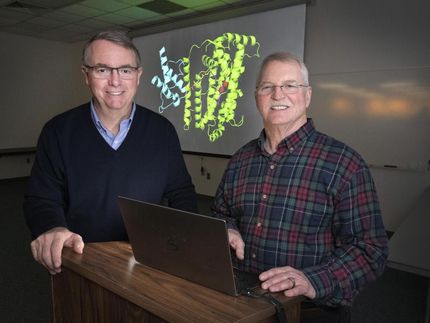Synthetic enzymes could help ID proteins
'Smart' catalysts programmed to recognize specific molecular shape
Using a rare metal that's not utilized by nature, rice University chemists have created a synthetic enzyme that could help unlock the identities of thousands of difficult-to-study proteins, including many that play key roles in cancer and other diseases.
The research was published online in the Journal of the American Chemical Society.
"We have combined the chemical capabilities of rhodium with what biology already knows about recognizing and selecting specific proteins," said study co-author Zachary Ball, assistant professor of chemistry at Rice. "The result is a tool that, in many ways, is more powerful than any biological or chemical approach alone."
Ball began studying dirhodium catalysts more than three years ago. He did not start out trying to create enzymes with them, but he was intrigued by a study that showed dirhodium catalysts could be used to modify tryptophan, one of the 21 amino acids that are the basic building blocks of life.
Catalysts enhance chemical reactions by increasing the rate of reaction without being consumed themselves. In living things, proteins called enzymes serve the same purpose. But unlike many inorganic catalysts, enzymes are very selective. In a process that biologists often liken to a "lock and key," enzymes associate only with molecules that match their shape exactly. This prevents them from spurring extraneous reactions throughout the cell.
Ball and postdoctoral research associate Brian Popp wondered if they could marry the selectivity of enzymatic reactions with a rhodium-based catalyst. They tested the idea by attaching their catalyst to a short segment of protein that can wrap with other proteins, like strands of rope fiber. This "coiled coil" wrapping motif is common in biology, particularly in signaling proteins. Signaling proteins are those that activate or deactivate key processes like apoptosis, the "programmed death" response that's known to play a key role in cancer.
"Signaling pathways are like a trail of dominos," Ball said. "Dozens of proteins can be involved, and they interact one after the other in a cascade. In most cases, the interactions are both fleeting and weak. They are difficult to observe with traditional methods, and as a result we are still in the dark about the roles that key signaling proteins play in health and disease."
Ball said his and Popp's synthetic enzyme strategy might help solve that problem. In their tests, the chemists were able to develop synthetic enzymes that could selectively bind with proteins and attach tags that would allow biologists to identify them.
In addition to tryptophan, the method worked with phenylalanine and tyrosine, two amino acids commonly found in signaling proteins. And recent unpublished studies indicate the researchers' strategy might work for even more amino acids.
Ball said the process must be refined before it can be used in the majority of biology labs, but he and Popp are already working toward realizing broad applications of the strategy.
Most read news
Other news from the department science

Get the life science industry in your inbox
By submitting this form you agree that LUMITOS AG will send you the newsletter(s) selected above by email. Your data will not be passed on to third parties. Your data will be stored and processed in accordance with our data protection regulations. LUMITOS may contact you by email for the purpose of advertising or market and opinion surveys. You can revoke your consent at any time without giving reasons to LUMITOS AG, Ernst-Augustin-Str. 2, 12489 Berlin, Germany or by e-mail at revoke@lumitos.com with effect for the future. In addition, each email contains a link to unsubscribe from the corresponding newsletter.






















































